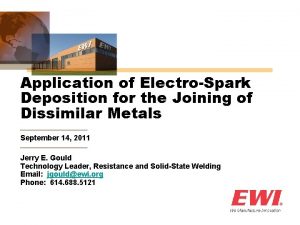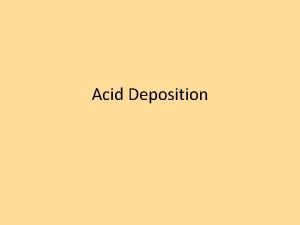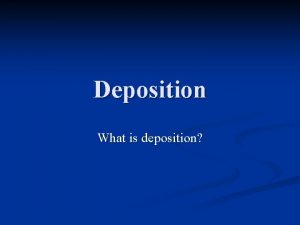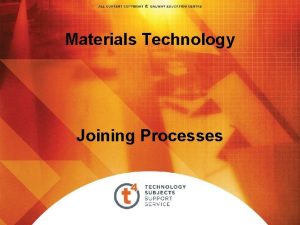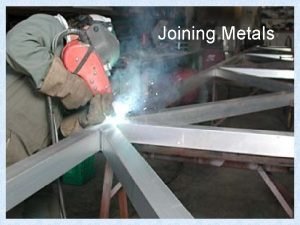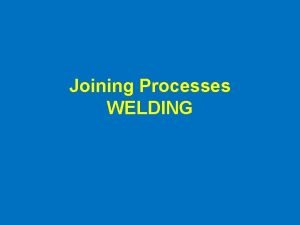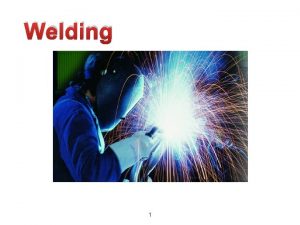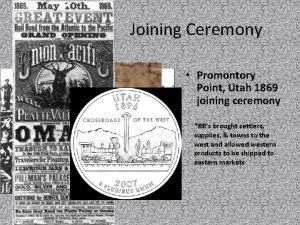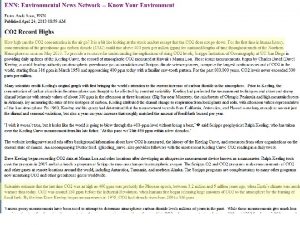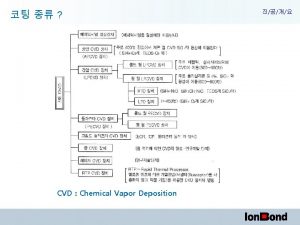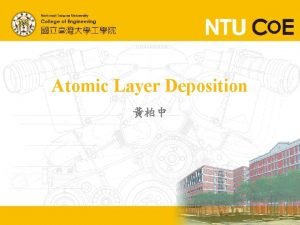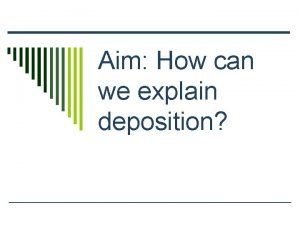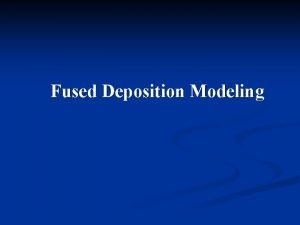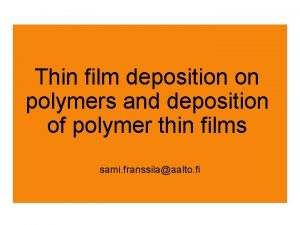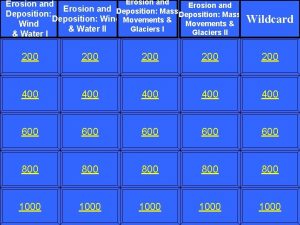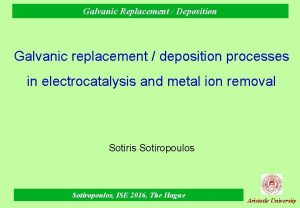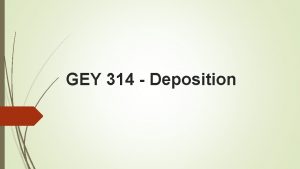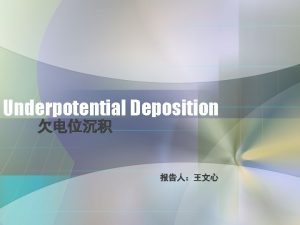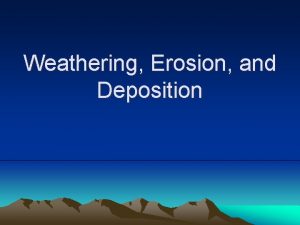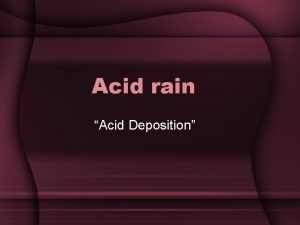Application of ElectroSpark Deposition for the Joining of

























- Slides: 25

Application of Electro-Spark Deposition for the Joining of Dissimilar Metals September 14, 2011 Jerry E. Gould Technology Leader, Resistance and Solid-State Welding Email: jgould@ewi. org Phone: 614. 688. 5121

Topics to be Addressed ― Functionality of the electro-spark deposition process ― Application for joints between Nibased superalloys and refractory metals ― Observed microstructures ― Resulting mechanical

Electro-Spark Deposition (ESD) Process u ESD processing characteristics ─ ─ ─ u ESD torch ─ ─ u u Repeat fire capacitive discharge power supply Discharge pulse widths on the order of 35 μs Peak currents on the order of 100 s of amps Hand held Rotating electrode Short circuit sparking Transfer of small metal volumes (microns in diameter) to substrate

Firing Efficiency of Electro-Spark Deposition ― ― ― Firing rates defined by control system Individual pulse widths on the order of 10 s of microseconds Variable contact pressures affect workpiece resistance and current flow Sparking “efficiency” quality tool for assessing deposition characteristics 70 - 90% sparking efficiency deemed ideal

Electro-Spark Deposition (ESD) Process ― ESD deposit characteristics u u ― Deposit layers typically microns thick Deposition rates typically <100 μg/s Multiple layers to create a deposit Virtually no heating of the substrate Application to complex materials joining problems u u u Small splat sizes to achieve a fine material grain structure Fast cooling rates (>105 -o. C/s) Non equilibrium solidification and suppression of solid-state transformations

Thermal Analysis of Various Localized Deposition Processes Arc and Laser Processes: ESD:

Ni-Superalloy to Refractory Metal Joints for Space Nuclear Propulsion ― Nuclear-powered space propulsion ― Lunar-based power ― Gas cooled reactor ― Brayton cycle energy conversion ― Refractory metals at/near

Material Combinations of Interest ― Refractory to nickel -based superalloy joints ― Refractory metal alloys u Mo-47. 5 Re u T-111 (Ta-8%W 2%Hf) ― Nickel-based superalloys u Hastelloy X u Mar M 247

Electro-Spark Deposition Welding Trials u u ASAP 50 -μF electro-spark deposition system Welding trials to be done in chamber ─ ─ u Material combinations ─ ─ u Hard glove box Oxygen levels <1 ppm Hard Glove Box with ESD Unit used Throughout these Trials Mo-47 Re strip to Mar M 247 strip T-111 strip to Mar M 247 strip Mo-47 Re strip to Hastelloy X strip T-111 strip to Hastelloy X strip All materials 0. 5 -mm flat stock ESD Torch and Manual Manipulation used Throughout these Trials

Electro-Spark Deposition Welding Trials – Set-Up ― Bonding procedure u Machined joint prep u ESD fill u Joint prep on reverse side u Final fill ― Practice taken from EWI experience ESD Electrode ESD Specimen Weld groove to be filled with deposited metal

Electro-Spark Deposition Welding Trials u u u Welding of ½ tensile specimens Weld prep Deposition practice: ─ ─ u Hastelloy X electrode (1. 5 -mm diameter) 40 -μF capacitance 120 -V charging voltage 500 -Hz firing rate Joint Preparation and Electrode Orientation for the ESD Welds made in this Study Three specimens for materials combination ─ One for metallographic sections ─ ─ Fill patterns Internal fill quality Intermetallic formation Two samples each for mechanical testing ESD Weld Current Waveform Taken from a Representative Deposit

Wrought Base Metal Microstructures Microstructure of the Hastelloy X Base Metal Typical of the Material used in this Study Microstructure of the Mo-47%Re Base Metal Typical of the Material used in this Study

Mar. M 247 Base Metal Microstructures Fine-Grained Mar. M 247 Base Metal Coarse-Grained Mar. M 247 Base Metal

Electro-Spark Deposition Welding – Mo-47%Re to Hastelloy X Final Geometry of a ESD Joint u Procedure included ─ ─ u u Cross Section of a Mo-47%Re to Hastelloy X ESD Weld Fill of initial groove Formation of back groove Filling back groove Sideplates used to improve joint geometry Fill nominally >99% dense Splat size nominally 10 -μm thick Fill showed good adhesion to both components Processing time: 8 hr/specimen Microstructural Details of the Hastelloy X Deposit

Electro-Spark Deposition Welding – Mo-47%Re to Hastelloy X u Hastelloy X/deposit interface ─ ─ ─ u Good adhesion of deposited material No degradation of base material noted Splat size in deposit on the order of the BM grain size Details of the Hastelloy X/Deposit Interface Mo-47%Re/deposit interface ─ ─ ─ Good deposit adhesion noted Little or no dillution with base metal No evidence of second phases Details of the Mo-47%Re/Deposit Interface

Electro-Spark Deposition Welding – Mo-47%Re to Mar. M 247 u Joint macrostructure ─ ─ ─ u Fill characteristics similar to that for other ESD welds Apparent adherence to both the Mo-47%Re and Mar. M 247 materials Two-side deposition evident Mar. M 247/deposit interface ─ ─ Good adhesion of deposited material Apparent reaction zone between the base metal and deposited splats Interface morphology similar to that seen for magnetic pulse welds Reaction zone on the order of microns thick Cross Section of a Mo-47%Re to Mar. M 247 ESD Weld Details of the Mar. M/Deposit Interface

Electro-Spark Deposition Welding – T-111 to Hastelloy X u Joint macrostructure ─ ─ ─ u Fill characteristics similar to that for other ESD welds Apparent adherence to both the T-111 and Hastelloy X materials Two-side deposition again evident Cross Section of a T-111 to Hastelloy X 247 ESD Weld T-111/deposit interface ─ ─ ─ Good adhesion of deposited material No apparent reaction zone No apparent thermal degradation of the base material Details of the T-111/Deposit Interface

Electro-Spark Deposition Welding – T-111 to Mar. M 247 u Joint macrostructure ─ ─ ─ Fill characteristics similar to that for other ESD welds Apparent adherence to both the T-111 and Mar. M 247 materials Two-side deposition again evident Cross Section of a T-111 to Mar. M 247 ESD Weld

Tensile Properties of ESD Welded Ni-Base Superalloy/ Refractory Metal Combinations Base Metal Properties of the Various Substrates Taken from Standard Reference Texts Material YS (MPa) UTS (MPa) Mar. M 247 828 966 Mo-47%Re 848 1034 T-111 613 679 Hastelloy X 379 767 u u Duplicate Tensile Test Results from Each Material Combination ESD Welded with a Hastelloy X Filler Refractory Metal Superalloy Yield stress (MPa) UTS (MPa) % strain Mo-47 Re Mar. M 247 813 817 0. 6 Mo-47 Re Mar. M 247 784 807 0. 4 Mo-47 Re Hastelloy-X 430 586 3. 5 Mo-47 Re Hastelloy-X 466 698 5. 5 T-111 Mar. M 247 611 682 4. 7 T-111 Mar. M 247 607 683 8. 5 T-111 Hastelloy-X 465 618 4. 3 T-111 Hastelloy-X 460 645 6. 4 u Duplicate tensile tests conducted for each material combination Tensile yield strengths at or above that of the Hastelloy X filler Elongations dependent on: ─ ─ Strengths of the substrates relative to the filler Ductility of the individual substrates

Estimation of Cooling Rates During Electro-Spark Deposition – Stage 1: Heat of Fusion Driven (1) u ─ ─ u (2) u u (3) u u (4) (5) Two stage analysis u Heat of fusion conduction Latent heat conduction One dimensional nonsteady-state solution (1) Conduction driven boundary condition (2) Heat generation through solidification (2) Defined thermal gradient at solidification boundary (3) Integration to define solidification time (4) Defined transition time between solidification and latent heat driven cooling rates (5)

Estimation of Cooling Rates During Electro-Spark Deposition – Stage 2: Latent Heat Affects (6) (7) u u u Transition to latent heat driven conduction Definition of thermal gradient from solidification analysis (6) Substitution to define final expression (7) Predictions of cooling rates at solidification terminus Cooling rates from 107 to 109 -o. C/s Cooling rates affected by conductivity of the substrate

Metallurgical Implications of ESD welding Dissimilar Material Joints ― Effects of high cooling rates on solidification u u u ― Effects on solid-state phase transformations u u u ― Equally high solidification rates Dendritic solidification without segregation Solidification morphology surface tension rather than compositionally driven Elimination of drivers for solidification cracking Potential for a wide range of solidsolution phases High cooling rates suppress second phases Allows super-saturated phases to exist at room temperature Potential for complex phase distributions with post-weld heating Parallels in other pulse weld technologies u u Magnetic pulse welding Percussion welding Hastelloy X Deposit on a Mo-47%Re Substrate

Summary ― Characteristics of electro-spark deposition processing u u u ― Electro-spark deposition welding Ni-based superalloys to refractory metals u u u ― One dimensional analysis Based on solidification of a single splat Cooling rates at termination of solidification on the order of 107 to 109 -o. C/s Influence of high cooling rates u u u ― Adaptable to all material combinations Fill densities >98% No evidence of detrimental phase formation Processing times ~8 hr/sample Mechanical properties defined by those of the base materials Thermal analysis of the ESD process u u u ― Repetitive capacitive discharge process Deposition volumes on the order of 100 μm 2 Adaptable to difficult materials combinations Solidification without apparent segregation Suppression of solid-state phase transformation products Presence of uniform non-equilibrium super saturated phases Considerable potential for dissimilar material combinations

Questions? Jerry E. Gould Technology Leader, Resistance and Solid-State Welding e-mail: jgould@ewi. org Phone: 614. 688. 5121

 Electro spark deposition
Electro spark deposition Semi permanent fixing methods
Semi permanent fixing methods Atmosfr
Atmosfr Verifikationsplan
Verifikationsplan Tidbok
Tidbok Rutin för avvikelsehantering
Rutin för avvikelsehantering Meios steg för steg
Meios steg för steg Presentera för publik crossboss
Presentera för publik crossboss Fuktmätningar i betong enlig rbk
Fuktmätningar i betong enlig rbk Fspos
Fspos Myndigheten för delaktighet
Myndigheten för delaktighet Var 1721 för stormaktssverige
Var 1721 för stormaktssverige Tack för att ni har lyssnat
Tack för att ni har lyssnat Tobinskatten för och nackdelar
Tobinskatten för och nackdelar Referatmarkeringar
Referatmarkeringar Boverket ka
Boverket ka Varför kallas perioden 1918-1939 för mellankrigstiden?
Varför kallas perioden 1918-1939 för mellankrigstiden? Karttecken tät skog
Karttecken tät skog Mjälthilus
Mjälthilus Avrunda decimaltal
Avrunda decimaltal Formel för lufttryck
Formel för lufttryck Elektronik för barn
Elektronik för barn Borra hål för knoppar
Borra hål för knoppar Mat för unga idrottare
Mat för unga idrottare A gastrica
A gastrica Smärtskolan kunskap för livet
Smärtskolan kunskap för livet
